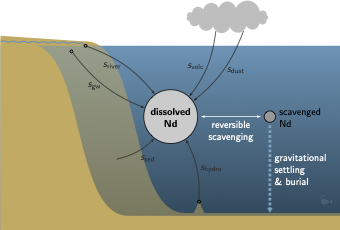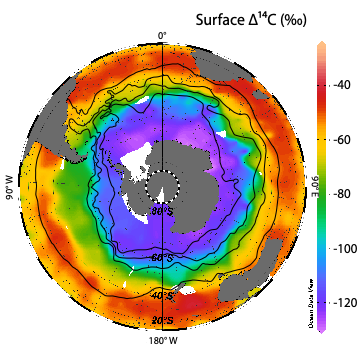Research Projects
Our lab group seeks to understand the role of the global-scale ocean circulation in past climate change over a range of timescales. The deep ocean interacts and feeds back on many other key parts of the Earth's climate system, including the carbon cycle, atmosphere, and cryosphere. Understanding these interactions in the past will help us better understand how climate may change in the future.

Ocean-climate feedbacks during the warmer-than-present last interglacial
The last interglacial, 129 - 115 thousand years ago, is considered one of the best analogs for the global climate state projected for the end of this century. As part of the Marie Curie project "MIS-5e", led by Postdoc Anastasia Zhuravleva, we will seek to understand the feedbacks between ocean circulation variability and carbon cycling during this period. Together with Kassandra Costa (WHOI) and Eleni Anagnostou (GEOMAR), we will analyze several sediment cores and corals from the North Atlantic using geochemical proxy indicators of past ocean and climate states (e.g., εNd, δ13C, Cd/Ca, δ11B).

Water mass structure and circulation changes in the Northeast Atlantic
The Iberian Margin in the Northeast Atlantic is well-known for its high accumulation rate sediment sequences that preserve millennial-scale climate variability over the late Pleistocene. As a member of the IODP Expedition 397 Scientific Party, I helped to collect sediments from a depth transect of sites that will extend these records back in time. I plan to examine the vertical structure of water mass changes over the mid- to late-Pleistocene in collaboration with other members of the Scientific Party.

Understanding how benthic fluxes of neodymium impact the isotopic composition of North Atlantic Deep Water
The isotope ratios of neodymium in seawater have the potential to provide key information about ocean circulation, both today and in the past, and can help shed light on the underlying drivers of global climate. However, uncertainties in our understanding of neodymium cycling in the modern ocean have limited the widespread use of this tracer. In this project we focus on the Labrador Sea, a key region for the formation and transport of North Atlantic Deep Water. Along with co-PIs from University of Delaware and California State University Bakersfield, we will collect seawater, porewater from short sediment cores, and deep ocean particulates to quantify benthic Nd fluxes and better understand Nd cycling in this region.

Modeling neodymium cycling in the modern ocean
We have developed a model of the modern marine neodymium cycle, GNOM v1.0, that uses observations to constrain modeled processes, simultaneously optimizing ~40 parameters. Due to its architecture, this model is both high-resolution and incredibly fast to run. We are now working to extend this model to investigate past ocean states, such as the Last Glacial Maximum, along with collaborators at WHOI, University of Southern California, and Texas A&M University.

Deep-sea corals as paleoceanographic archives
Fossil deep-sea corals are an exciting and unique paleoceanographic archive. We primarily use the species Desmophyllum dianthus (pictured to the left). Deep-sea corals incorporate sufficient uranium from seawater to be precisely U/Th-dated, the inherent stratigraphy of their skeletons allow for resolution of decadal changes in ocean biogeochemistry, and their large size accommodates multiple geochemical measurements on the same samples (e.g. radiocarbon, temperature, and neodymium isotopes). We are in the process of obtaining funding to collect some of these corals along the Walvis Seamounts in the Southeast Atlantic. This will help us investigate changes in intermediate water circulation and other Southern Ocean processes over the most recent glacial termination.

Interocean exchange via the Agulhas Leakage and its connection to global ocean circulation
The 'Great Ocean Conveyor' connects the shallow and deep ocean circulation and plays a crucial role in global climate. A key part of this is the formation of North Atlantic Deep Water in the high-latitude North Atlantic, supplied by shallow feed water via Drake Passage (the cold route) and the Agulhas Leakage (the warm route). We have been investigating variations in the Agulhas Leakage over the glacial cycles of the past million years and how they connect to changes in North Atlantic Deep Water circulation. This is part of a collaborative project with researchers at Lamont-Doherty Earth Observatory, Scripps Institution of Oceanography, Hostos Community College, and Cardiff University.

Radiocarbon changes in the Southern Ocean over the past 30,000 years
The Southern Ocean is uniquely important in the global overturning circulation, as it is the only place where there is both deep water formation and upwelling. Radiocarbon is a powerful tracer of deep ocean circulation, but due to the dynamics of the Southern Ocean, radiocarbon values at the surface are not spatially uniform, leading to uncertainty in deep ocean reconstructions. This project seeks to reconstruct radiocarbon values in subantarctic surface water to reduce these uncertainties. It is led by PI Christopher Charles at Scripps Institution of Oceanography.